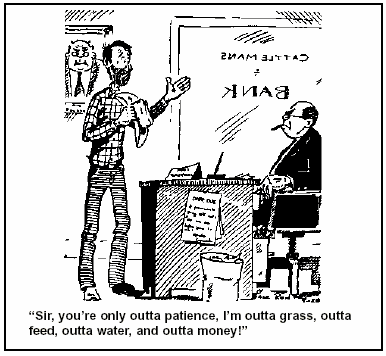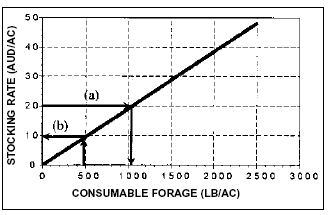



Do You Have Enough Forage?
By Larry D. White, Extension Range Specialist, Texas Cooperative Extension. The next time you drive or ride through your pasture checking livestock, water troughs, or fences, take the time to check your forage supply, too.Routinely checking forage supplies ensures timely decisions that would have kept Jake (Figure 1) from being “outta grass, outta water, and outta money.” If Jake had monitored his forage supply and compared it with the grazing requirements for his livestock, he could have acted sooner. To limit the impact of a forage crisis situation, the rancher must recognize forage shortfalls and make timely decisions.

Many ranchers find themselves in Jake’s situation because they failed to recognize a potential crisis. By culling a few head early, the rancher increases forage for the core breeding herd. During prolonged droughts, a rancher should follow one of these options:
- Reduce the size of the herd to ensure that the pasture is undamaged.
- Purchase all forage.
- Lease additional grazing.
- Sell out completely .
Rainfall is less effective when plant and litter cover on the soil surface is reduced. Since the amount and distribution of rainfall limit forage production, your management should promote rainfall infiltration and reduce evaporation and erosion. Preparing for the next drought is an important part of good management; to be prepared, follow these recommendations:
- Maintain carryover forage.
- Have a flexible herd composition.
- Periodically rest pastures. Deferment is never a loss of forage; it is just a period for increasing plant vigor and forage supply for later use.
- Sell early—cull when the drought begins, to reduce leasing and feeding costs.
- Have an orderly marketing system.
- Wean early.
- Inventory forage at the first sign of drought.
How much forage do I have?
Experienced ranchers have lived through wet and dry cycles, and they understand forage accumulation and disappearance and livestock gains and losses. Some managers can just “tellby looking at it” if the forage they have is enough for the planned stocking rate and for improving the land resource. However, a systematic approach can improve decisions, evaluations, and reduce the risk to ranch resources associated with forage shortages. To evaluate your current situation and determine if your stocking rate should be adjusted to balance the forage needed with the current forage supply, follow these five steps:- Determine how much forage you will need for grazing animals on the planned grazing schedule.
- Determine the amount of forage you want to leave ungrazed to protect the resource.
- Calculate the amount of forage supply you will need to last until the forage recovers.
- Check your pastures to determine if the current forage supply is greater than the amount you need.
- Make your decisions and implement them based on current and forecast conditions .
How much forage do I need?
A livestock inventory gives you the basic information for calculating the forage supply needed for consumption by livestock. During the process of grazing, forage is trampled, dropped, or eaten to provide the daily intake. Under moderate grazing, research indicates an intake efficiency of 50 percent. So, for each pound eaten, a pound is returned to the pasture as litter (important for protecting the soil).Forage needed for grazing animals. Since most ranchers already have stock grazing their ranches, they need to determine their current stocking rate for the pastures to be grazed until forage recovery normally occurs.
To determine your current stocking rate, first inventory the animals (number), then determinethe animal unit equivalent (A.U.E.) for each kind, and total the A.U.E.’s for the herd(s) (Table 1). From a planned grazing schedule, determine the number of days the herd(s) will graze the pasture(s). Next, multiply your total A.U.E. by the number of days of grazing to determine the animal unit days (A.U.D.) per pasture. Divide this number by the acreage of the pasture; the answer is your stocking rate (A.U.D. per acre).
One A.U. consumes 26 pounds of forage (oven dry weight) per day, but under moderate stocking will waste an equal amount (so a total of 52 pounds per day is required). In the example shown in Table 1, the rancher plans to graze the pasture(s) for 150 days at a stocking rate of 19.8 A.U.D. per acre.

Forage to be left ungrazed. The amount of forage that should be left ungrazed will depend on the type of desired forage plants, your goals for improvement, and amount of risk you are willing to assume. Future forage production depends on healthy, desirable forage plants and productive soils that survive drought, high rainfall events, and grazing, and that recover quickly under favorable conditions.
The risk of increased rainfall runoff and loss of soil that can be a non-point source pollutant in streams and lakes increases as the amount of forage you leave ungrazed decreases. So, the amount of plant cover directly influences the amount of soil moisture following rainfall. Table 2 shows the minimum amounts of ungrazed forage on different types of rangeland necessary to ensure good plant health, effective rainfall infiltration, and soil protection.

Supply needed until forage recovers. The minimum forage supply required equals the sum of the consumable forage and the amount to be left ungrazed.
From Figure 2, read the amount of consumable forage needed for the example shown above. The amount of consumable forage needed for a stocking rate of 19.8 A.U.D. per acre is 1,030 pounds per acre (a). If midgrass was the desired plant community to be maintained, 750 pounds per acre left ungrazed plus the 1,030 pounds per acre needed for consumption means that the pasture must have more than 1,780 pounds per acre of current forage supply.
 Figure 2. The amount of consumable forage required at different stocking rates for moderate use.
Figure 2. The amount of consumable forage required at different stocking rates for moderate use.A: 20 A.U.D./A. = 1,040 lb./A. of consumable forage.
B: If the forage supply provides 490 lb./A. of consumable forage, then the proper stocking rate is 9.4 A.U.D./A.
Checking the pasture to determine if the supply is greater than the amount needed. Based on the calculated needed forage supply, a rancher can visually inspect the pasture to determine if current conditions are adequate. Using experience or photoguides (Texas Agricultural Extension Service publication B- 1646 is a good example), you can determine if the needed forage supply is currently available, for example, the 1,780 pounds per acre computed earlier. Consider only the grazeable area that produces forage, not the total pasture acreage.
If the forage supply is greater than the amount needed, then the supplies should last longer than the 150 days. So, you could increase your stocking rate, or you could maintain the stocking rate and use the extra forage to promote improvement, consider it reserve forage, or use it for prescribed fire. If the forage supply is less than the amount needed, immediately reducing your stocking rate will maintain more of the forage for a greater number of “best” performers, with minimum impact on the resource and financial returns.
How do I use this information in making management decisions?
Decisions to change your stocking rate can have major effects on ranch resources. Perform (or have someone else perform) an economic evaluation before selling any livestock. But remember that maintaining ownership of livestock during a drought has a serious impact on your financial and range resources. More detailed forage surveys and analyses can be performed if warranted.Don’t delay a decision that creates the crisis Jake had to admit to his banker. If your forage survey indicates a shortfall, act now!
Reducing the stocking rate. You can calculate your needed reduction in stocking rate using the same formula shown above, if you determine an estimate of your current forage supply.
For the example discussed above, if the current forage supply was estimated to be 1,240 pounds per acre, only 490 pounds per acre is available for consumption. Using Figure 2, this equals 9.4 A.U.D. per acre of grazing remaining for the 150-day grazing period (b). A reduction of 10.4 A.U.D. per acre is required on the 750 acres to be grazed. Multiply the A.U.D. per acre by the total acres to determine the number of A.U.D. of grazing remaining (9.4 X 750 = 7,067). Divide the A.U.D. of grazing by the number of days the pasture is to be grazed to determine the number of A.U. that can be grazed (7,067 : 150 = 47). This survey indicatesthat the herd should be reduced by approximately 50 percent if other forage is not available.
The longer a decision is delayed, the greater the number of animals that will have to be removed from the pasture or the greater the risk of damaging the pasture from excessive use. Delaying implementation adversely affects both the range and your financial resources.
Managing pastures. Pastures should be checked frequently, but especially near the end of normal year forage growth periods and at the end of winter when accumulated forage is normally required to last through normal nongrowth periods. Checks in June, November, and March are recommended for most Texas situations. Pastures should be rechecked periodically and compared with the calculated projections. Because of the seasonal cycle of forage growth and natural disappearance, most ranchers will want to plan forage supplies to last well beyond the next forage survey and the time when normal regrowth should occur. Ranchers should allow forage to carry over from one season into the next.
Summary
Your annual planned stocking rate should be high enough to allow financial survival, but low enough to sustain or improve your range resource. A sustainable stocking rate higher than needed to financially survive can be reduced accordingly in dry years without jeopardizing the survival of the ranch. Short-term profits will be reduced, but the ranch is still yours and the rapid recovey following drought allows increased net cash flow without having to pay off drought debt.Visual monitoring of pastures using the calculated needed forage supply provides early warning so that you can evaluate and implement alternatives in a timely manner. Establish decision dates for implementating needed stocking rate adjustments—without depending on hope for good rains when they normally don’t happen or when, if they do, they’re too little and too late to be of much benefit.herd size gradually, while maintaining good body condition and reducing risk.
Balance your stocking rate with the available forage supply to provide adequate consumption and forage left ungrazed to protect the soil resources and to promote next season’s regrowth. The calculations are not difficult and can provide measurable criteria for you to evaluate each time you check your livestock and pastures.
April 2007


